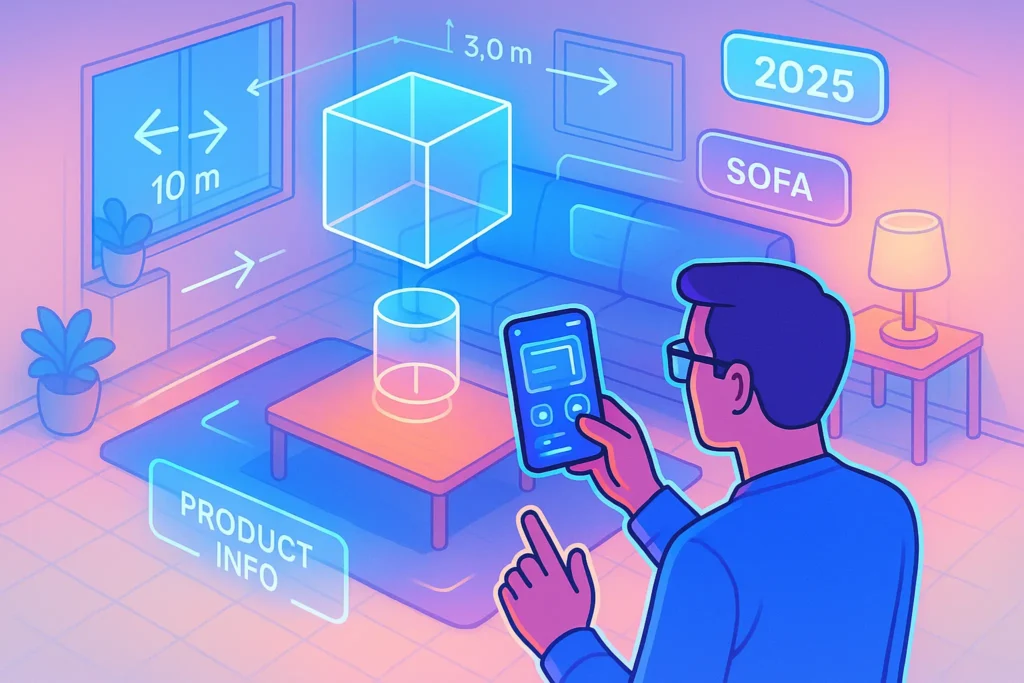🧠 Introduction
Remember when augmented reality was just about catching a Pikachu in your park?
Fast forward to 2025, and AR has become a layered interface between digital data and physical space—showing up in everything from interior design apps to remote work tools, retail experiences, and spatial computing headsets like Apple Vision Pro.
But despite years of hype, AR hasn’t fully broken into the mainstream.
In this deep dive, we’ll explore where AR stands today, how mobile apps and hardware are converging into an ecosystem, and what needs to happen next for AR to become as natural as using a smartphone.
For foundational context, you might also want to check our post on AR and VR: The State of Immersive Tech, where we break down the mixed reality continuum.
🌐 The AR Ecosystem in 2025: More Than Just Headsets
The 2025 AR landscape is no longer dominated by futuristic glasses alone. It’s a hybrid ecosystem where software plays just as vital a role as hardware. It spans:
-
Mobile-first AR apps (e.g., IKEA Place, Snapchat Lens Studio, Adobe Aero)
-
Wearables like Apple Vision Pro, Meta Ray-Ban Smart Glasses, and Xreal Air 2 Ultra
-
Browser-based AR via WebXR on platforms like Shopify or 8thWall
-
Enterprise-grade tools for remote support, training, or 3D collaboration
The convergence of these layers is what makes AR in 2025 truly versatile. It’s no longer tied to one device class—but embedded across platforms.
We explored some of these overlaps in Smart Glasses: The Next Big Gadget or Just Hype?, where we highlighted how glasses are becoming portal devices rather than standalone machines.
🧾 What AR Is (and Isn’t) in 2025
Let’s clarify:
AR in 2025 is not just sci-fi overlays on a pair of glasses.
Instead, it’s become a modular experience layer—from basic phone screen interactions to fully immersive environments on high-end spatial devices.
| Misconception | 2025 Reality |
|---|---|
| “AR = only glasses” | ✘ No → Phones & browsers lead usage |
| “AR = always immersive” | ✘ No → Most AR is casual, not full-dive |
| “AR = for gamers only” | ✘ No → Education, shopping & remote work dominate adoption |
| “AR = low adoption” | ⚠️ Partial → Mobile AR usage is massive, wearables still niche |
In fact, platforms like Instagram AR filters and Snapchat Lenses have quietly trained over a billion users to interact with AR—without calling it AR.
🎮📚🏢 Where AR Is Actually Being Used: Real-World Applications
While sci-fi demos dominate headlines, the true impact of AR in 2025 is being felt in three major verticals—each with radically different needs.
1. Gaming & Entertainment
AR gaming exploded with Pokémon GO, but it’s evolved far beyond that. Platforms like Snap’s Lens Studio and Niantic’s Lightship now power location-based multiplayer games, interactive fan experiences, and AR-enhanced streaming overlays.
-
Popular Use Cases: Scavenger hunts, live events, gamified exercise apps
-
Trend: Gamified AR ads and influencer-hosted lens drops
2. Education & Training
AR is transforming how people learn—especially in STEM, medical, and industrial fields.
-
Apps like JigSpace or Merge EDU let students manipulate 3D objects directly on their tablet or desk.
-
Medical training now uses AR overlays for anatomy practice or procedure rehearsal—a practice gaining traction globally.
“AR turns theory into touchable knowledge. That’s the leap traditional e-learning never managed.”
— Dr. Priya Nehru, EdTech Researcher
3. Workplace & Collaboration
The rise of remote work has pushed AR into enterprise workflows. Think AR dashboards in logistics, field support tools, and mixed-reality whiteboarding.
Apps like Spatial, TeamViewer Frontline, and Microsoft Dynamics Remote Assist are actively used in logistics, factory training, and even healthcare.
If you’re curious how these tie into the bigger wearable picture, check out Wearable Tech in 2025, where we explored smart rings, body sensors, and B2B AR tools.
📱 Mobile AR Apps That Are Actually Useful
Despite the hype around headsets, mobile AR remains the most practical form of augmented reality today.
Here are some multi-purpose AR apps gaining traction in 2025:
🔹 IKEA Place
Still one of the best consumer-facing AR apps. Drop true-to-scale furniture into your space, now with AI layout suggestions and cross-room visualization.
🔹 Snapchat Lens Studio
Massive for creators and marketers. Enables 3D face effects, world lens effects, and now sponsored retail try-ons (e.g. trying sunglasses in AR).
🔹 Adobe Aero
A professional tool for creating immersive AR scenes, particularly for brands, museums, and exhibitions.
🔹 Measure by Apple / Google
Simple, utility-first app for measuring real-world objects via phone camera. Surprisingly popular in interior design and DIY communities.
🔹 ARway + WebXR Browsers
Used for spatial navigation, marketing installations, and “AR as a Service” platforms—especially in malls and events.
📌 The mobile phone isn’t just a stepping stone to AR—it’s the most adopted AR device ever built.
You can find more gadget-focused examples in our post on Top Futuristic Gadgets You Can Own Now, where we detail mobile and wearable hybrid tools.
🚧 What’s Still Holding AR Back?
Despite huge strides, several technical and cultural limitations still prevent AR from going fully mainstream:
🪫 Battery Drain
AR is resource-hungry. Between camera input, real-time mapping, and rendering, devices (especially phones) overheat or die quickly.
⏱️ Latency Issues
Especially on mobile, frame delay or misalignment kills the sense of realism. Without ultra-fast 5G/Wi-Fi and optimized chips, seamless AR feels far off.
🧠 Cognitive Overload
Poor UX design in AR apps can overwhelm users. There’s a fine line between immersive and confusing. Especially with unfamiliar gestures or misaligned 3D positioning.
👀 Social Comfort
Wearing smart glasses in public or constantly holding your phone to “see” through it still feels awkward for many users.
For a related discussion on how these affect device design, revisit Apple Vision Pro Review, where we explore comfort tradeoffs and UX in spatial computing.
🔮 What’s Next for AR: Breakthroughs That Could Change Everything
To push AR from niche to necessity, three key shifts must happen:
1. Battery & Chip Optimization
AR will only thrive when phones, glasses, and headsets can run it for hours without overheating. Apple’s M-series chips are making progress, but mobile silicon needs to catch up.
2. Content Ecosystem Maturity
We need more than filters and furniture. Imagine AR apps for writing, designing, coding, or managing projects in 3D space. That’s where innovation can make AR essential—not optional.
3. Cross-Platform AR Standards
Until AR experiences run seamlessly across Android, iOS, WebXR, and wearables, developers will struggle to build mass-adoption apps.
“AR’s biggest leap won’t be hardware—it will be invisible design that melts into our real-world flow.”
— Irene Tao, UX Research Lead at VXR Labs
🧪 What AR Feels Like in the Real World (Mini Use Scenario)
AR isn’t just a tech buzzword—it’s a shift in how we interact with digital information. Here’s how a real-world moment with AR unfolds:
🛋️ You’re at home browsing sofas online. Instead of guessing how they’d fit, you open the IKEA Place app. In seconds, your phone scans the room, places the couch in exact scale, and lets you switch fabrics—all in real-time.
🎨 Curious about how it looks in daylight? You rotate your phone toward the window, and the lighting updates automatically. You snap a photo and send it to your partner for feedback—no measuring tape, no imagination gymnastics.
That’s AR in action: bridging uncertainty with interactive context.
This is exactly the type of non-flashy, high-utility AR that’s gaining ground in 2025. As we noted earlier, mobile-first AR experiences like this continue to outpace even advanced headsets in practical adoption.
🧠 Stay Updated on AR, Spatial Interfaces & Immersive Tech
Join our newsletter to get future-forward insights on augmented reality apps, wearables, and the next wave of human–tech interaction.
Delivered weekly, curated for creators, tech leads, and early adopters.
🔒 No spam. Just sharp, timely content from NerdChips on what’s next in visual computing and smart interfaces.
🧭 Reality Check: Is Augmented Reality Ready for You?
Not everyone needs to jump on the AR train—yet. Here’s a quick guide to assess where you stand:
Is Augmented Reality Ready for You?
Try it now if:
– You’re a designer, educator, or content creator curious about spatial tools
– You want to enhance real-world tasks like shopping, training, or storytelling
– You enjoy exploring mobile apps that overlay useful data or 3D visuals
Maybe wait if:
– You expect flawless all-day AR wearables
– Battery life or visual comfort is a key concern
– You prefer traditional screens over spatial interaction—for now
Honest answer: AR is powerful, but still growing. Try light-touch use cases first—and expand if it clicks.
🧾 AR Maturity Scoreboard (2025)
A quick snapshot of where augmented reality really stands across categories:
| Area | 📊 Maturity Level | 🔍 Notes |
|---|---|---|
| Mobile AR Apps | ✅✅✅ High | Dominant form of AR use |
| Smart Glasses Adoption | ⚠️ Low | Still niche, UX + battery-limited |
| Enterprise AR | ✅✅ Medium | Steady in logistics, training |
| Education/Medical Use | ✅✅✅ Growing | Immersive learning value recognized |
| AR Gaming Platforms | ✅✅✅ High | Creator tools + Lenses booming |
| AR in Productivity | ⚠️ Early Stage | Immersive workspace still rare |
🧠 Nerd Verdict
AR in 2025 is not a gimmick—it’s a transition layer between the interfaces we know and those we’re slowly adopting.
It’s practical (via mobile apps), exciting (via wearables), and deeply creative (via platforms like Aero or Lens Studio). But until it solves latency, battery, and content problems, it won’t dominate—yet.
Still, if history repeats itself, the moment AR hits its iPhone moment, everything could change—fast.
❓ FAQ: Nerds Ask, We Answer
💬 Would You Bite?
🌍 Where do you see AR adding the most value—work, education, or entertainment?
Have you built or used an AR app that changed how you think about tech?
Drop your story or vision below.👇 Let’s map the augmented future—together.



